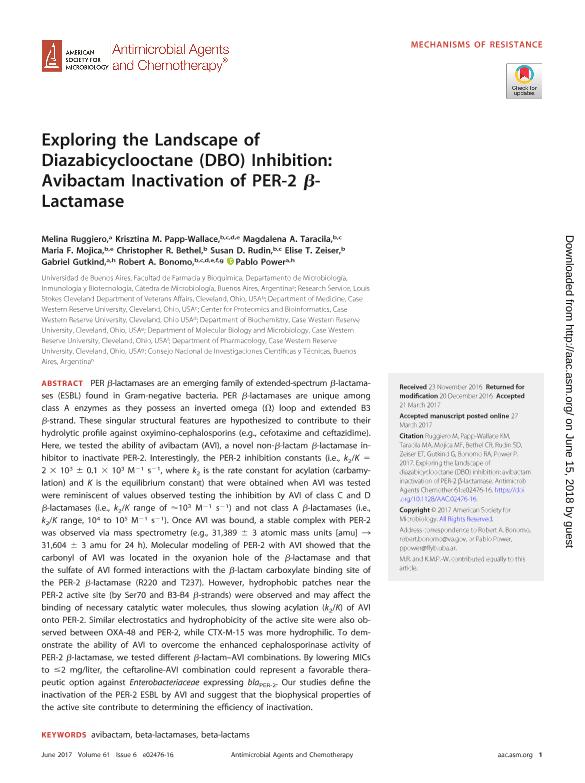Mostrar el registro sencillo del ítem
dc.contributor.author
Ruggiero, Melina

dc.contributor.author
Papp Wallace, Krisztina M.
dc.contributor.author
Taracila, Magdalena A.
dc.contributor.author
Mojica, Maria F.
dc.contributor.author
Bethel, Christopher R.
dc.contributor.author
Rudin, Susan D.
dc.contributor.author
Zeiser, Elise T.
dc.contributor.author
Gutkind, Gabriel Osvaldo

dc.contributor.author
Bonomo, Robert A.
dc.contributor.author
Power, Pablo

dc.date.available
2018-06-15T18:07:33Z
dc.date.issued
2017-06
dc.identifier.citation
Ruggiero, Melina; Papp Wallace, Krisztina M.; Taracila, Magdalena A.; Mojica, Maria F.; Bethel, Christopher R.; et al.; Exploring the landscape of diazabicyclooctane (DBO) inhibition: Avibactam inactivation of PER-2 β-Lactamase; American Society for Microbiology; Antimicrobial Agents and Chemotherapy; 61; 6; 6-2017
dc.identifier.issn
0066-4804
dc.identifier.uri
http://hdl.handle.net/11336/48832
dc.description.abstract
PER β -lactamases are an emerging family of extended-spectrum β -lactamases (ESBL) found in Gram-negative bacteria. PER β -lactamases are unique among class A enzymes as they possess an inverted omega (?) loop and extended B3 β -strand. These singular structural features are hypothesized to contribute to their hydrolytic profile against oxyimino-cephalosporins (e.g., cefotaxime and ceftazidime). Here, we tested the ability of avibactam (AVI), a novel non- β -lactam β -lactamase inhibitor to inactivate PER-2. Interestingly, the PER-2 inhibition constants (i.e., k2/K = 2 × 103 ±0.1 × 103 M-1 s-1, where k2 is the rate constant for acylation (carbamylation) and K is the equilibrium constant) that were obtained when AVI was tested were reminiscent of values observed testing the inhibition by AVI of class C and D β -lactamases (i.e., k2/K range of =103 M-1s-1) and not class A β -lactamases (i.e., k2/K range, 104 to 105 M-1s-1). Once AVI was bound, a stable complex with PER-2 was observed via mass spectrometry (e.g., 31,389 ± 3 atomic mass units [amu] ¡ 31,604 ± 3 amu for 24 h). Molecular modeling of PER-2 with AVI showed that the carbonyl of AVI was located in the oxyanion hole of the β -lactamase and that the sulfate of AVI formed interactions with the β-lactam carboxylate binding site of the PER-2 β -lactamase (R220 and T237). However, hydrophobic patches near the PER-2 active site (by Ser70 and B3-B4 β -strands) were observed and may affect the binding of necessary catalytic water molecules, thus slowing acylation (k2/K) of AVI onto PER-2. Similar electrostatics and hydrophobicity of the active site were also observed between OXA-48 and PER-2, while CTX-M-15 was more hydrophilic. To demonstrate the ability of AVI to overcome the enhanced cephalosporinase activity of PER-2 β-lactamase, we tested different β -lactam-AVI combinations. By lowering MICs to ≤2 mg/liter, the ceftaroline-AVI combination could represent a favorable therapeutic option against Enterobacteriaceae expressing blaPER-2. Our studies define the inactivation of the PER-2 ESBL by AVI and suggest that the biophysical properties of the active site contribute to determining the efficiency of inactivation.
dc.format
application/pdf
dc.language.iso
eng
dc.publisher
American Society for Microbiology

dc.rights
info:eu-repo/semantics/openAccess
dc.rights.uri
https://creativecommons.org/licenses/by-nc-sa/2.5/ar/
dc.subject
Avibactam
dc.subject
Beta-Lactamases
dc.subject
Beta-Lactams
dc.subject.classification
Otras Ciencias Biológicas

dc.subject.classification
Ciencias Biológicas

dc.subject.classification
CIENCIAS NATURALES Y EXACTAS

dc.title
Exploring the landscape of diazabicyclooctane (DBO) inhibition: Avibactam inactivation of PER-2 β-Lactamase
dc.type
info:eu-repo/semantics/article
dc.type
info:ar-repo/semantics/artículo
dc.type
info:eu-repo/semantics/publishedVersion
dc.date.updated
2018-06-07T14:22:08Z
dc.journal.volume
61
dc.journal.number
6
dc.journal.pais
Estados Unidos

dc.journal.ciudad
Washington
dc.description.fil
Fil: Ruggiero, Melina. Consejo Nacional de Investigaciones Científicas y Técnicas; Argentina. Universidad de Buenos Aires. Facultad de Farmacia y Bioquímica. Departamento de Microbiología, Inmunología y Biotecnología; Argentina
dc.description.fil
Fil: Papp Wallace, Krisztina M.. Louis Stokes Cleveland Department of Veterans Affairs; Estados Unidos. Case Western Reserve University; Estados Unidos
dc.description.fil
Fil: Taracila, Magdalena A.. Louis Stokes Cleveland Department of Veterans Affairs; Estados Unidos. Case Western Reserve University; Estados Unidos
dc.description.fil
Fil: Mojica, Maria F.. Louis Stokes Cleveland Department of Veterans Affairs; Estados Unidos
dc.description.fil
Fil: Bethel, Christopher R.. Louis Stokes Cleveland Department of Veterans Affairs; Estados Unidos
dc.description.fil
Fil: Rudin, Susan D.. Louis Stokes Cleveland Department of Veterans Affairs; Estados Unidos. Case Western Reserve University; Estados Unidos
dc.description.fil
Fil: Zeiser, Elise T.. Louis Stokes Cleveland Department of Veterans Affairs; Estados Unidos
dc.description.fil
Fil: Gutkind, Gabriel Osvaldo. Consejo Nacional de Investigaciones Científicas y Técnicas; Argentina. Universidad de Buenos Aires. Facultad de Farmacia y Bioquímica. Departamento de Microbiología, Inmunología y Biotecnología; Argentina
dc.description.fil
Fil: Bonomo, Robert A.. Louis Stokes Cleveland Department of Veterans Affairs; Estados Unidos. Case Western Reserve University; Estados Unidos
dc.description.fil
Fil: Power, Pablo. Consejo Nacional de Investigaciones Científicas y Técnicas; Argentina. Universidad de Buenos Aires. Facultad de Farmacia y Bioquímica. Departamento de Microbiología, Inmunología y Biotecnología; Argentina
dc.journal.title
Antimicrobial Agents and Chemotherapy

dc.relation.alternativeid
info:eu-repo/semantics/altIdentifier/doi/https://dx.doi.org/10.1128/AAC.02476-16
dc.relation.alternativeid
info:eu-repo/semantics/altIdentifier/url/http://aac.asm.org/content/61/6/e02476-16
Archivos asociados
